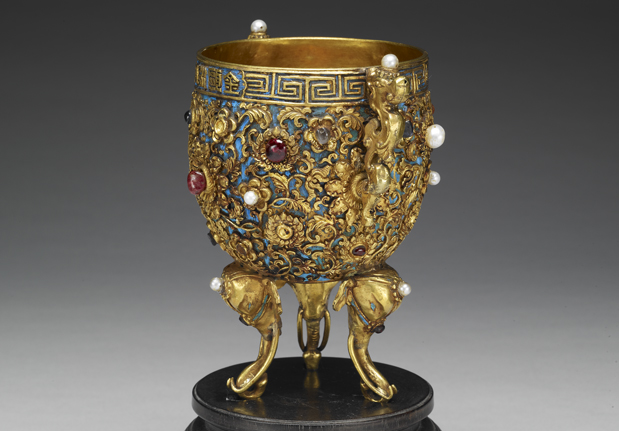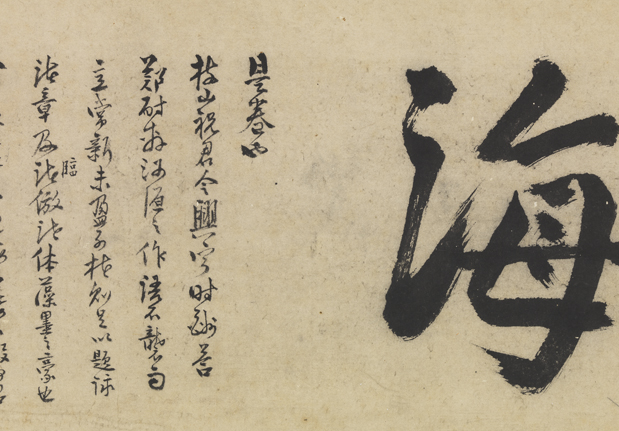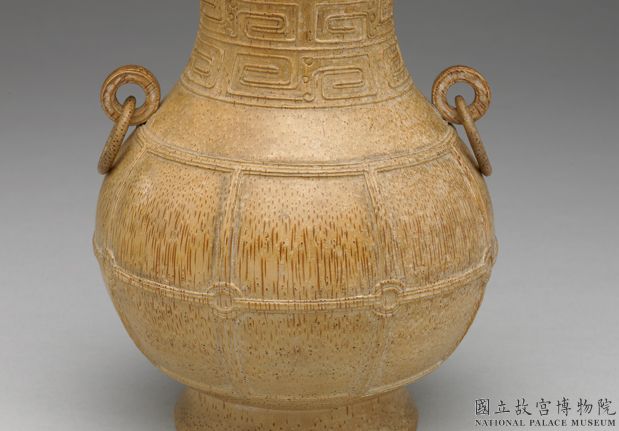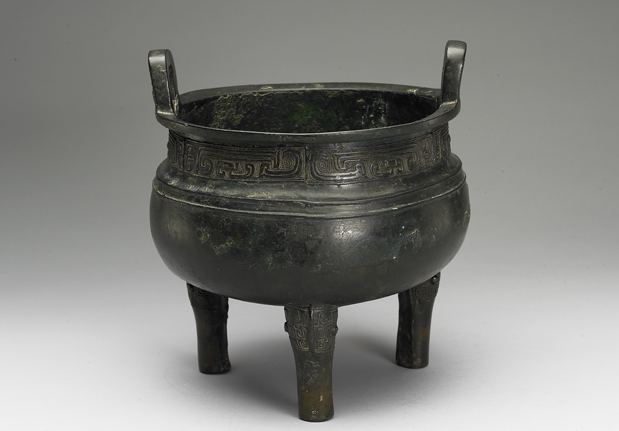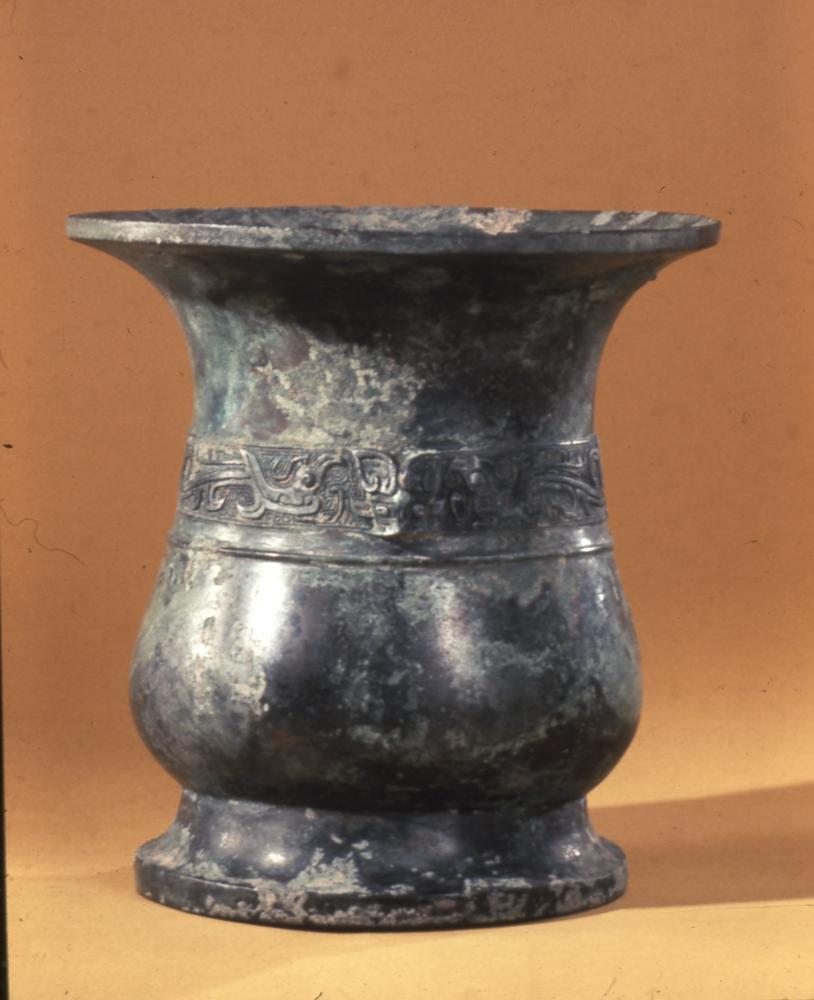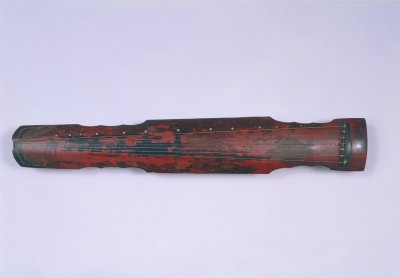Period:Ming dynasty Production date:1573-1620
Materials:porcelain, lacquer, gold,
Technique:glazed, lacquered, gilded, underglazed,
Subjects:religious object mythical figure/creature dragon landscape
Dimensions:Height: 34.50 centimetres Width: 35.50 centimetres
Description:
Square porcelain altar vase in the shape of a ‘zun’ with underglaze blue, and red lacquer with polychrome filled-in and engraved-gold decoration. This square altar vase demonstrates the use of a rare decorative technique employing red lacquer with polychrome filled-in (‘tianqi’) and engraved-gold (‘qiangjin’) designs on a porcelain body. Although modelled after an ancient bronze wine container called a ‘zun’, it is probable, because of its elongated proportions, that the shape was copied from a printed illustration rather than from an original Bronze Age vessel. Applied to each side around the middle are relief-moulded heads of fantastical lion-like beasts painted in underglaze blue, pierced through for the attachment of rings. Also in underglaze blue is a horizontal six-character Wanli reign mark below the rim. Traditional imperial dragons with five claws, horns, scaly bodies, bushy manes, whiskers, tails and eyebrows are depicted in different attitudes with stylized waves and mountains in red lacquer with yellow, green and black pigment infill. The outlines of the design and details such as the dragon’s scales are emphasized by gilded lines. Where patches of lacquer have been lost, it can be seen that the white porcelain body was biscuit fired before the lacquer decoration was added. The base has a low outer footband and is unglazed.
IMG
![图片[1]-altar-vase(zun) BM-1921-1121.1-China Archive](https://chinaarchive.net/Ming dynasty/Ceramics/mid_00256795_001.jpg)
![图片[2]-altar-vase(zun) BM-1921-1121.1-China Archive](https://chinaarchive.net/Ming dynasty/Ceramics/mid_00228505_001.jpg)
Comments:Harrison-Hall 2001:Red lacquer with combined filled-in and engraved-gold decoration was especially popular in the Wanli reign. After the colours were inlaid into the lacquer and the surface polished, fine lines were incised to emphasize the design and these were then filled with gold leaf or fine gold dust. Wanli commissioned many lacquer wares of this type during his reign. James Watt has noted that many of the surviving lacquer wares of this type with dated inscriptions were made in 1595, such as a dish and a tray in the Metropolitan Museum of Art, New York, and two dishes in the Hong Kong Museum of Art. It is probable that the present vase also dates to this period. Its lacquer work was extensively repaired and missing areas painted at the British Museum in 1991 in preparation for the opening of the Joseph E. Hotung Gallery of Oriental Antiquities.
Materials:porcelain, lacquer, gold,
Technique:glazed, lacquered, gilded, underglazed,
Subjects:religious object mythical figure/creature dragon landscape
Dimensions:Height: 34.50 centimetres Width: 35.50 centimetres
Description:
Square porcelain altar vase in the shape of a ‘zun’ with underglaze blue, and red lacquer with polychrome filled-in and engraved-gold decoration. This square altar vase demonstrates the use of a rare decorative technique employing red lacquer with polychrome filled-in (‘tianqi’) and engraved-gold (‘qiangjin’) designs on a porcelain body. Although modelled after an ancient bronze wine container called a ‘zun’, it is probable, because of its elongated proportions, that the shape was copied from a printed illustration rather than from an original Bronze Age vessel. Applied to each side around the middle are relief-moulded heads of fantastical lion-like beasts painted in underglaze blue, pierced through for the attachment of rings. Also in underglaze blue is a horizontal six-character Wanli reign mark below the rim. Traditional imperial dragons with five claws, horns, scaly bodies, bushy manes, whiskers, tails and eyebrows are depicted in different attitudes with stylized waves and mountains in red lacquer with yellow, green and black pigment infill. The outlines of the design and details such as the dragon’s scales are emphasized by gilded lines. Where patches of lacquer have been lost, it can be seen that the white porcelain body was biscuit fired before the lacquer decoration was added. The base has a low outer footband and is unglazed.
IMG
![图片[1]-altar-vase(zun) BM-1921-1121.1-China Archive](https://chinaarchive.net/Ming dynasty/Ceramics/mid_00256795_001.jpg)
![图片[2]-altar-vase(zun) BM-1921-1121.1-China Archive](https://chinaarchive.net/Ming dynasty/Ceramics/mid_00228505_001.jpg)
Comments:Harrison-Hall 2001:Red lacquer with combined filled-in and engraved-gold decoration was especially popular in the Wanli reign. After the colours were inlaid into the lacquer and the surface polished, fine lines were incised to emphasize the design and these were then filled with gold leaf or fine gold dust. Wanli commissioned many lacquer wares of this type during his reign. James Watt has noted that many of the surviving lacquer wares of this type with dated inscriptions were made in 1595, such as a dish and a tray in the Metropolitan Museum of Art, New York, and two dishes in the Hong Kong Museum of Art. It is probable that the present vase also dates to this period. Its lacquer work was extensively repaired and missing areas painted at the British Museum in 1991 in preparation for the opening of the Joseph E. Hotung Gallery of Oriental Antiquities.
© Copyright
The copyright of the article belongs to the author, please keep the original link for reprinting.
THE END
